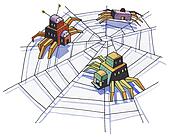 |
| Writing to attract web crawlers |
How to bring these two divergent writing personalities together?
That is the question --- And, if answered, will empower digital writers to dance and swing across all media formats with stupendous success.
Michelle Wicmandy, contributor to Website Magazine, has this to say in the February, 2013 issue:
Captivating Readers While Attracting Web Crawlers
Today’s digital writer has two audiences: readers and Web crawlers. Unfortunately, the two have distinct tastes.
The latter, for example, prefers keyword repetition, which works to achieve higher search engine rankings (thus, maintain visibility with an audience). This “over-optimized” style of writing, however, can attract Web crawlers but can also lose a reader’s interest. On the contrary, online readers demand relevant information in easy, bite-sized pieces. Being brief, by using sentence fragments, bullet points and reporting “just the facts” increases reader interest but may sacrifice SEO-driven rankings.
And, despite the different preferences of readers and Web crawlers, both are seemingly interrupting the creative prose of yesterday.
“It’s not a trend I agree with,” said Lynda McDaniel, founder of the Association for Creative Business Writing and co-founder of The Book Catalysts. “That [brevity] style won’t bring anything to life, especially not the readers. Writing is the portal to our thoughts, and if we write in snippets, our thoughts will be just as abbreviated. To keep your content interesting and hold the reader’s attention; write to the reader, write for the reader and write from the heart. Write as if you’re talking with a friend — or at least someone representative of your readership. Engage the reader with stories and compelling information, not just short little blurbs.”
Words trigger emotion and form bonds with the reader. McDaniel thinks an importance should be placed on writing interesting content using clarity, fresh associations and interest angles. To create visuals and actions in the reader’s mind, try incorporating a few of the following techniques:
Appeal to the senses: Use language to paint imagery, create sound and describe an aroma, taste or texture. For example, if your business received an award, try “Within minutes of the news, music rocked the room and champagne corks were popping,” instead of “We won the award.”
Document sources to support opinions: To support ideas and attract Web crawlers, provide evidence from reliable, credible sources, such as research organizations, traditional media, government sources and associations.
Develop a sense of scale: Create an analogy using common knowledge to present unfathomable ideas, such as large numbers. Not only does this add interest, but it is also powerful imagery. For example, 1 second is 1 second (and easy to comprehend), but 1 million seconds is equivalent to 12 days. And, 1 billion seconds is equivalent to 30 years. Describing a product that measures 3.3 x 2.2x 0.8 inches? Don’t leave the reader guessing about what that means. Explain that it fits inside of an Altoid mint container.
Read and learn more
Get the Writers Welcome Blog on your Kindle :)))
No comments:
Post a Comment